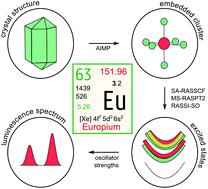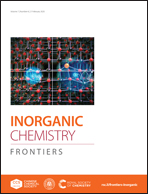Insights into the complexity of the excited states of Eu-doped luminescent materials†
Abstract
It has always been a spectroscopist's dream to correlate a material's luminescence properties with its microscopic structure, based on reliable structure–property relationships. Electronic structure methods are promising to achieve this goal; yet they are especially challenging in the case of Eu-based materials which are known to feature exceptionally high density of excited states, large spins and severe electron correlation. In this work, state-of-the-art multiconfigurational ab initio embedded-cluster methods are applied to gain a deeper insight into the luminescence mechanisms of Eu2+ and Eu3+-doped phosphors. Regardless of the difficulties, very accurate excitation energies are achieved, reaching 68% prediction intervals of 300 cm−1, corresponding to an accuracy of 5–10 nm in the visible wavelength range. Complete configurational coordinate curves are obtained, yielding breathing mode vibrational frequencies and equilibrium bond lengths for all excited states. Moreover, electric dipole transition moments and oscillator strengths are used to calculate absorption spectra. Excellent agreement with experiment is found. The ab initio calculations give an unprecedented detailed view of the Eu2+ excited state landscape, allowing for an improved understanding of its structure, including the origin of the so-called ‘staircase structure’ and the role of ligand covalency in the ligand field and exchange splitting. It is found that more covalent host compounds feature higher exchange splittings due to an increased stabilization of high-spin states by the interaction with virtual LMCT states. It is verified that the equilibrium Eu–ligand bond length contracts upon 4f–5d excitation towards the lowest 5d submanifold and that the bond lengths are directly related to the configurational character of the electronic eigenstate. Moreover, comparing ab initio calculations with crystal field calculations proves that a decoupled model for the Eu2+ excited states is inadequate, making the use of an intermediate coupling scheme compulsory. With this approach, computational design of luminescent materials is getting within reach.

- This article is part of the themed collection: 2019 Inorganic Chemistry Frontiers HOT articles


 Please wait while we load your content...
Please wait while we load your content...